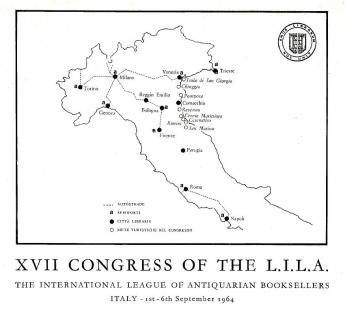17th ILAB Congress at Cervia-Milano Marittima, September 1 - 6, 1964

By S.C. (Stanley Crowe?)
At the invitation of the Italian Association, approaching 200 delegates and friends, drawn from 14 nations, gathered at Milano-Marittima on Tuesday, September 1, for the 17th Congress of the ILAB. Milan-Marittima is a seaside resort on the Adriatic Coast, about 10 miles from Ravenna. It is entirely a modern development with spacious tree-lined avenues, and really an extension of neighbouring Cervia, whose history dates from Roman times.
While the Annual Congress is primarily an Annual General Meeting and performs an essential function in this respect, it is, however, in the accompanying social programme that most delegates find greatest interest. It lies in the special opportunities afforded in a gathering of this sort to meet or get to know those of like kind in other nationalities and, in particular, to learn more of the country in which the Congress takes place. The organising committee and the presidents of the various delegations all work hard. The ordinary delegates and their friends are mainly free to enjoy themselves. It is the prerogative of any member of any national association to join a congress and take advantage of a unique opportunity, on payment of the participation fee. I was such a one, so that this is the Congress as seen by a very ordinary delegate.
In the evening of September 1, the congressists met for the first time at a reception given by the Mayor of Cervia at the Imperial Hotel. They were welcomed first by the Mayor, and then by Signor Bourlot, President of the Italian Association, who announced that he and his colleagues had arranged a programme which they hoped would give both pleasure to the congressists and also enable them to see some of the places of interest. Indeed, the fullness and generosity of this programme was to be truly demonstrated in the next five days.
First, the work of the Congress. The delegates met at two general assemblies on September 3 and 6, in the “Teatro Comunale”, in Cervia. This is a small, charming, 18th century theatre, on a circular plan recently renovated and decorated in white and gilt, overhung with an elegant painted ceiling, and with tiers of boxes which some delegates chose to occupy. The President, Officers and Committee were seated on the stage.
From the Dutch delegation came a proposal of real importance - to organise an International Antiquarian Book Fair under the auspices of the League. Amsterdam, in the autumn of 1965, was suggested as place and time. The proposition was admirably presented in carefully thought out terms. Each delegate was handed a sheet of paper setting out detailed information, and the proposal received ready acceptance. In a world of ever-widening vistas, this would seem a natural development from the national Antiquarian Book Fairs commenced in London and followed by those in Germany, Holland and the USA. As I saw it, this was a positive feature which, achieving the success it deserves, would contribute to the strength and stature of the International League.
Adjourning to the cloisters, we were welcomed by the Mayor of Ravenna and offered refreshments. Afterwards there was just time for a brief visit to Dante’s tomb and to the church of St. Francis. In the latter I saw, for the first time, the alarming evidence of a city slowly sinking - the crypt was filled with water to a depth of about two feet. Subsequently, I was to see other indications of the enormous problems presented by a city which in the course of centuries, has slowly sunk until now it is now in part below sea-level.
On Thursday, soon after 9.30 am, the party was speeding in motor coaches northward to the historic town of Cesena, to visit the renowned “Maletestina” Library. This was a “chained” library founded during the Renaissance and the first public library in history. Forming part of a fine Renaissance building, the original library is preserved as it was, with the 16th century reading-desks still with large volumes attached by chains. It possesses a wealth of medieval and Renaissance manuscripts. On arrival, we found in other parts of the building a magnificent display of many of the treasures set out for us to see. In small groups we were allowed to visit the old library. The few minutes spent in the quiet of this ancient Library, with its centre aisle of delicate columns, and into which daylight found free access, was for me a high spot in the whole week. There was a strange feeling of repose, and the sight of the old reading-desks with their chained books brought to mind the unending sequence of those who came here in times long past, seeking knowledge, or whose minds had quickened with new ideas. As I gazed at the old shining seats, I ruminated on the venerable, famous or infamous backsides which in the course of centuries had pondered there, each adding something to the smoothness and lustre of these ancient benches. I thought of Galileo and Luther though I had no reason to suppose they were ever there, but to men of similar calibre this would indeed have been a haven.
By this time appetites were sharpening and the treat arranged for us that day by our hosts is likely to live long in the memory of many. We were to lunch at the world-famous Casali Restaurant, in Cesena. The meal and service were superlative but there are times when superlatives have little meaning. I heard those afterwards who voted this the best meal they had ever eaten. An early return was made to Milano Marittima for the General Assembly that evening where, not surprisingly, heads were seen to nod!
Friday’s programme was full and generous. Venice was to be the ultimate destination. The motor-coaches were away soon after 9 am. A stop was made at the fine old Abbey of Pomposa, standing warm and mellow in the sunshine, and then on again to Chioggia, at the southernmost point of the Venetian lagoon. Chioggia is sometimes described as “Little Venice”. After a quick look at this picturesque old town and an excellent lunch, we were off again on the last stage of our journey.
Arriving at Venice, two steamers took us aboard and we sailed down the historic Grand Canal and out to the island of San Giorgio. Venice is unique and beautiful, and its impact is always fresh. There is nothing in the world like the continuous panorama of the Grand Canal, and many of the names and sights are familiar to those who have never been there. On the island of San Giorgio we visited the Cini Foundation, a series of artistic and cultural institutes, with a fine library, established in ancient monastic buildings. The Reception Committee to meet us was noticeably absent, and we learnt that shortly before us Princess Margaret had arrived. In early evening the steamers took us for a brief visit to St. Mark’s Square, and soon after 6 pm, the return journey began. For the young and tireless, a later steamer and coach was arranged. A comfortable journey back brought a memorable day to a close.
On Sunday morning there was a last look at some of the architectural wonders of Ravenna. Two things were impressed on my mind: the notice on the Cathedral door forbidding the bringing of bicycles into church, and the mausoleum of the Empress Galla Placidia, built about the year AD 450. The exterior is not specially eye-catching, but inside the mosaic decoration is rich and beautiful. The tomb itself is empty as many years ago the children wishing to get a better look at her remains thrust a torch inside, and that was the end of the Empress Galla Placidia.
All good things come to an end. On Sunday evening, at 9 pm., the congressists gathered at the Hotel Deanna for the last time, for the farewell dinner and dance, over which Signor Bourlot presided. Finally the President of each delegation rose to offer thanks to the Italian Antiquarian Booksellers for their generous hospitality and untiring efforts, and for having made this a memorable week for everyone.
Extract from ABA Miscellany Number 3 (1965). Click above to read the original program.




